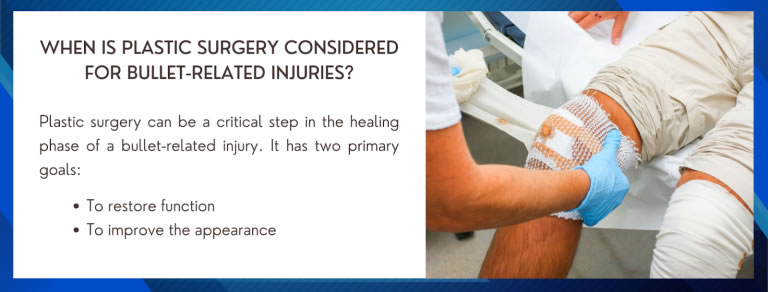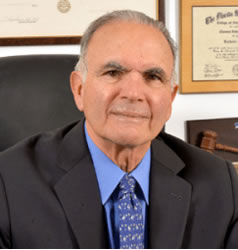Bullet wounds are devastating injuries that inflict significant physical damage. However, the impact goes far beyond the initial trauma. Survivors often face long-term challenges with mobility, function, and appearance. Fortunately, modern medicine offers a powerful tool for recovery: reconstructive plastic surgery.

Reconstructive plastic surgery plays a crucial role in the healing process, offering not just physical repair but also a path toward emotional and psychological well-being.
This blog post explores the role of plastic surgery in treating bullet-related injuries and aiding recovery.
What are the physical effects of bullet wounds?
Bullet wounds are injuries caused by a projectile fired from a firearm. These injuries can vary depending on the type of gun used, the distance from which the shot was fired, and the part of the body that was struck. Common effects of bullet wounds include:
- Tissue damage
- Bleeding
- Bone fractures
- Nerve damage
- Organ damage
The trauma doesn't stop at the physical level. Survivors of bullet wounds often experience post-traumatic stress disorder (PTSD), anxiety, and depression. The visible scars can be a constant reminder of the event, impacting self-esteem and social interaction.
When is plastic surgery considered for bullet-related injuries?
Reconstructive plastic surgery is a specialized field of medicine that focuses on restoring function and appearance after injuries or congenital conditions. In the case of bullet wounds, surgery can be a critical step in the healing journey.
Typically, plastic surgery is considered once the patient is medically stable and the initial trauma has healed. The timing can vary depending on the complexity of the injury.
Reconstructive surgery for bullet wounds has two primary goals:
- Restoring function: This involves repairing damaged nerves, muscles, and tendons to regain mobility and functionality in the affected area. For example, surgery might address nerve damage in the arm, allowing the patient to regain control and use of their limb.
- Improving appearance: Reconstructive surgery can address visible scarring, tissue loss, and other cosmetic concerns. This can significantly improve a patient's self-image and confidence.
What are the different types of reconstructive procedures used for bullet-related injuries?
The specific type of reconstructive surgery depends on the nature of the injury. Here are some common procedures:
Skin grafts and flap surgery
Skin grafts involve transplanting healthy skin from another area of the body to cover a wound. Flap surgery uses nearby healthy tissue to reconstruct damaged areas. These procedures can address significant tissue loss and scarring.

Bone reconstruction
Bullet wounds can cause bone fractures and damage. Reconstructive surgery can involve realignment and stabilization of broken bones, sometimes using plates, screws, or bone grafts. This can restore stability and improve functionality.
Facial reconstruction
Facial injuries from bullet wounds can be particularly devastating. Reconstructive surgery can address bone fractures, soft tissue damage, and nerve damage in the face. This can restore facial features, improve function (like chewing or blinking), and enhance overall appearance.
Tendon repair
Bullet wounds can sever or damage tendons, compromising movement and function in the affected area. Reconstructive surgeons can meticulously repair these delicate tissues, restoring flexibility and allowing patients to regain control of their limbs.
Nerve repair or grafting
As mentioned earlier, nerve damage can be a significant consequence of bullet wounds. Reconstructive surgery offers techniques like nerve repair (suturing severed nerves) or nerve grafting (using healthy nerves from another body part) to restore nerve function and potentially regain sensation and muscle control.
Scar revision
While skin grafts address significant tissue loss, scar revision focuses on improving the appearance of existing scars.
This can involve techniques like scar reduction, scar camouflage, or Z-plasty (a surgical technique that rearranges scar tissue to create a more aesthetically pleasing appearance).
Learn more about plastic surgery for scars on our website.
Vascular reconstruction
Bullet wounds can damage blood vessels, leading to blood flow problems and potential tissue death. Reconstructive surgeons can perform vascular reconstruction procedures like grafting or bypass surgery to restore blood flow and promote healing in the affected area.
How can plastic surgery help patients cope with the trauma of their injuries?
Reconstructive plastic surgery, while primarily focused on physical repair, can play a surprisingly crucial role in helping patients cope with this trauma in several ways:
Improved self-esteem
Reconstructive surgery might restore functionality and improve the appearance of the injured body part. This can empower the patient to feel comfortable engaging in social activities again, fostering a sense of normalcy and reducing feelings of isolation.
Reduced anxiety and depression
Surgery might improve the appearance of the scar, making it less noticeable. This can lessen the anxiety associated with social interactions and potentially contribute to a sense of closure related to the traumatic event.
Empowerment and regaining control
The physical limitations and disfigurement caused by bullet wounds can leave patients feeling powerless and out of control. Fortunately, reconstructive surgery restores the function and improves the appearance of our patients, thus allowing them to regain control of their lives.
Heal and Rebuild with Dr. Thomas Zaydon
If you're seeking the best possible care for bullet wound reconstruction, look no further than Dr. Thomas Zaydon of the Plastic Surgery Institute of Miami.
Dr. Zaydon is a board-certified plastic surgeon with over 20 years of experience specifically dedicated to helping patients heal from a wide range of injuries, including bullet-related ones.
He is renowned for his meticulous surgical techniques and extensive knowledge of reconstructive procedures. He understands the complexities of bullet wounds and is committed to achieving the best possible outcomes for his patients.
Moreover, Dr. Zaydon's expertise extends far beyond bullet-related injuries. He is a valuable expert in the medico-legal field of plastic surgery, such as:
Contact us today and let Dr. Zaydon help you heal, rebuild, and reclaim your life.
***
The material contained on this site and in this article is for informational purposes only and DOES NOT CONSTITUTE THE PROVIDING OF MEDICAL ADVICE, and is not intended to be a substitute for independent professional medical judgment, advice, diagnosis, or treatment. Always seek the advice of your physician or other qualified healthcare providers with any questions or concerns you may have regarding your health.











